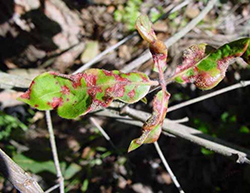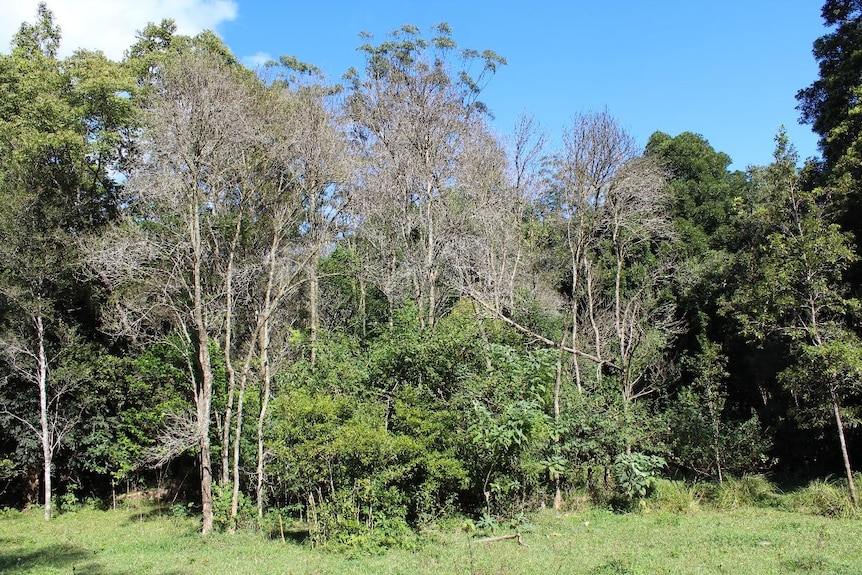Myrtle rust (Austropuccinia psidii), originally from South America, was first found in plants in Australia on the NSW central coast in 2010 and, unfortunately, is a real stand-out among plant diseases!
Rusts are caused by fungi and get their name from the raised brownish spots on the above-ground parts of infected plants, although the spots can also be orange, yellow, black or white. In myrtle rust, the disease usually starts as small purple spots. Yellow pustules of spores then form in those spots and over time fade to grey. Myrtle rust usually attacks young growth, like leaf buds, but can also attack flower buds, flowers and fleshy fruits. The myrtle rust fungus spreads mainly by wind-borne spores, but those spores can also be spread by animals, from clothing, boots, tools, vehicles and dumped plant material. A single spore that infects a plant can mature and produce thousands of new spores within 12 days. This makes myrtle rust almost impossible to eradicate!
Rust diseases in plants, world-wide, are nothing new. There are a lot of native rust species in Australia in various plant families. Wheat farmers have probably had to deal with rusts since wheat was first developed 8,000 years ago. In Australia, William Farrer is well-known for breeding rust-resistant varieties of wheat in the late 19th century. Farrer’s work brings out one aspect of the myrtle rust problem: the susceptibility of plants to diseases that those plants have not co-evolved with. There are very few native rusts that affect native Australian plants in the myrtle family (Myrtaceae), which includes, for example, eucalypts, tea-trees, paperbarks, and lilly pillies, and none of those rusts is closely related to myrtle rust. Consequently, the resistance to myrtle rust in Australian native Myrtaceae plants is not likely to be high, although resistance may vary across different genera and plant forms (i.e. dense shrubs, tall trees etc.) (https://www.dpi.nsw.gov.au/biosecurity/plant/insect-pests-and-plant-diseases/myrtle-rust). Most rusts each usually infect only a small range of species. One particular feature of myrtle rust, though, is that it’s not too choosy about host species. It does prefer moist habitats and so is not likely to be a threat in drier parts of the country.



In 2005, myrtle rust was found in Hawaii and, since then, has spread by unknown pathways around the western Pacific area. Since its arrival in 2010 in Australia, with its wide potential range of host species and preference for moist environments, it is now present along the northern coast from the Northern Territory eastwards and down the entire east coast to the NSW-Victorian border, with some infestations in Victoria and Tasmania. In 2016, it was found on Lord Howe Island and, because of the particular characteristics of the outbreak (geographical isolation of the infestation, early detection and a quick, well-organised response), was actually eradicated by 2017. However, in February 2023, it was found on the island again, quite possibly spread there via wind-borne spores from Australia. In early March, the Permanent Park Preserve (the area similar to a national park) on the island was closed to visitors, while the outbreak was dealt with. By the end of March, the outbreak seemed to have been contained and the park was reopened to visitors. Regular monitoring is continuing and critical hygiene protocols that visitors must follow are in place, with park staff stationed at key track heads to demonstrate these protocols.
The loss of plant species does not just reduce plant biodiversity, but has a knock-on effect through loss of shelter, nesting sites and food sources for invertebrates, birds and mammals, which then reduce in numbers as a result. These losses may also in turn have a damaging effect on, for example, primary production industries and ecotourism, as well as increasing the scale and cost of environmental remediation.
While the outlook may seem quite grim, plant scientists have found that there is genetically-based resistance to myrtle rust in some species. This holds out some hope that those individual plants of a particular species with the specific genetic make-up that gives them resistance to myrtle rust may survive, reproduce and spread over time. However, this development of natural resistance will happen only where the decline in native species caused by myrtle rust is fairly slow, as decline in native species caused by myrtle rust usually moves a lot faster than the development of genetic resistance to the fungus in those species.
Apart from hoping for some limited natural resistance developing, there is a national action plan for managing myrtle rust. Last year, a survey of seed banks, botanic gardens, arboreta and their nurseries across Australia was done to list the Myrtaceae species they held. This information will help focus conservation efforts for species affected by myrtle rust. The Australian Institute of Botanical Science is on the front foot in work to preserve species under threat. They use seed banking, tissue culture and long-term shoot tip preservation and DNA analysis in their work. Coming down to tin tacks for home gardeners, what can we do to prevent the spread of myrtle rust? There are a few main measures:
- learn how to recognise myrtle rust (to learn what myrtle rust looks like, follow the various links in this article and “Further information” below to find lots of photos)
- use a fungicide, if necessary (see Agriculture Victoria link below for more information)
- remove plants likely to be susceptible before they’re infected
- plant non-susceptible plant species instead (check susceptibility of different species – it varies!)
- remove diseased plants, bag up all material and dispose of in household waste – to avoid further spread, don’t put it in green waste or compost
- wash all your gardening clothing and tools after gardening
Bushwalkers need to be mindful too.
Anyone in NSW who discovers an outbreak of myrtle rust is required by law, under the general biosecurity duty, to eliminate or minimise the outbreak, if it’s found on an area they are responsible for. However, myrtle rust is not a notifiable plant disease in NSW and so someone who discovers an outbreak does not have to notify the biosecurity unit in the NSW Department of Primary Industries (Biosecurity Act 2015 (NSW)). While we don’t have to notify the biosecurity unit if we find an outbreak, they would still like to be notified, so they can decide if they need to follow it up. They particularly need to know if there’s an outbreak near any native bush, reserve, forest or agricultural land, as the consequences of myrtle rust spreading into those areas are serious. So, if you think you’ve found it – anywhere! – it’s best to report it.
Another measure is to make your views about the chronic lack of government support and resources dedicated to preserving Australia’s native biodiversity known to your local politicians!
Not long after myrtle rust was first found in Australia, a CSIRO scientist said, “Australia appears to be a very nice place for myrtle rust”. Myrtle rust cannot be eradicated, so let’s all play our part in trying to minimise its impact!

Further information
The summary article above is based on information from the the sources linked in the article itself and most of the sources given below.
There is a lot of information about myrtle rust becoming available. A central source for this is the Australian Network for Plant Conservation (ANPC) information hub. In that hub, you’ll find a very good short video about myrtle rust and a recording of a recent webinar on the topic. The video linked in the article above, one of the “What the flora!” series from the Sydney Royal Botanic Gardens, is also excellent. On the ANPC web page, there are links to the national action plan and a detailed report, “Myrtle Rust reviewed”, containing a wealth of information (the report has very useful information for gardeners without a lot of botany behind them all the way through to plant scientists, so pick and choose what you read!).
There are some very good photos to help you identify myrtle rust here. .
There are some general hygiene guidelines relating to preventing the spread of disease here.
You can find more details about measures you can take to prevent or control myrtle rust infection here:
- NSW DPI
- Agriculture Victoria (particularly useful)
- Tasmania DPI
People who are professional researchers and managers of myrtle rust can join their colleagues at the Australasian Myrtle Rust Conference in late June 2023 in Sydney.
